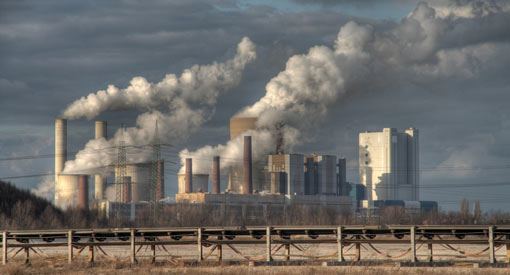The world’s most developed nations, according to a new report released Monday, are not doing nearly enough to meet their promised reductions of carbon emissions aimed at keeping global temperatures from exceeding 2 degrees Celsius this century,
And these nations—including the United States, France, and other leading economies in Europe—are not missing their reduction obligations by a small amount. Rather, according to the Low Carbon Economy Index report—conducted by the UK-based global accounting firm PricewaterhouseCoopers (PwC)—these nations are emitting carbon at more than five times what they ought to be if the world is to stave off the worst impacts of global warming and climate change.
While some nations have made gains in reducing their levels of pollution, the United States is among those performing most poorly.
“After a decade of carbon inertia, we are way behind, and now need to decarbonise at more than five times our current rate to avoid 2°C,” said PwC’s Leo Johnson. “Making up for the inadequacy to date will be technologically harder, financially costlier, and climactically riskier in the future.”
And John Grant, director of the sustainability and climate change department at PwC,writes at the Guardian on Monday:
The world is currently on track to burn this century’s IPCC carbon budget within 20 years, and a pathway to 4C of global warming by 2100. For many of us, 2034 is within our working lifetime. It’s within the timeframe of decisions being made today, on long-term investments, on the location of factories and their supply chains. So businesses are making those decisions faced with uncertainty about climate policy and potential impacts of climate change.
It is clear that the gap between what governments are saying about climate change and what they are doing about it continues to widen. While they talk about two degrees at the climate negotiations, the current trend is for a 4C world.
Nearly 200 nations have signed onto a non-binding agreement to lower emissions enough so that temperatures stay beneath the 2 degree threshold, but repeated studies and analyses have shown that continued inaction by governments and increased fossil fuel consumption worldwide is pushing the trends in the exact opposite direction.
As Sandy Dechert, writing at Clean Technica, writes:
With the Copenhagen agreement five years ago, almost 200 countries agreed at United Nations climate talks to adopt “the scientific view that the increase in global temperature should be below 2 degrees Celsius” (3.6 degrees F) above pre-industrial times, while growing world economies, to combat climate change. This would curtail increases in heat waves, floods, storms, and sea level rise due to natural and human-induced climate change.
At about 0.85 degrees C, we citizens of the world are now almost halfway there. The latest studies indicate that we may be approaching the serious risk of runaway climate change. In this report, PwC says that (1) we have missed the global carbon intensity (greenhouse gas emissions per $GDP) reduction target every year, and (2) we need to decrease energy-related carbon emissions by more than five times the rate we are currently achieving.
The Low Carbon Economy Index report reveals major disconnects between the global climate negotiations goal of a 2°C rise limit, current national pledges (which add up to a 3°C rise), and our current trajectory, which is actually on course for 4°C. (Disruption, released last night as 350.org’s leadup film to its climate march in two weeks, sees us on track for 6°C.) Current rates of carbon intensity mean that we’ll reach the total amount of carbon the world can “safely” emit this century within 20 years.
As indicated by Dechert, the report from PwC—used widely by industry investors and calculated alongside projections of economic growth—comes just weeks before the next round of international climate talks are scheduled to place at the United Nations in New York City on September 23. It is in the context of runaway emissions and continued inaction at the government policy level which has led global climate justice advocates to demand that “business as usual” when it comes to the fossil fuel industry must now come to an end.
As part of their effort to radically transform the nature of the debate and the policies that are on the table, the organizers behind the “People’s Climate March & Mobilization” are increasingly asserting the fact that the physics of planetary warming and climate change will no longer wait for incremental reforms. Instead of promises and agreements, they declare, the people of the world must rise up, wrest control from those who would continue to watch the world burn, and take action.




People, each of us, are on this planet for a very short time. For any of us to “know” how this planet and climate work long term is a farce. Climate change, global warming, Taliban, chem trails, communists and every other scare tactic has been thrown at us forever. Even chicken little fell for it, and the last time I checked the sky was still above us. All these issues only serve to give those in charge yet another reason to waist our tax dollars with a big lie. If enough of the Lemmings believe what they’re told, there’s going to be a big mess at the bottom of the cliff. I wonder what environmental impact that will create and how much it will cost us.
Well Mitch, thank goodness others stayed in school and learned a lot more than you did. Join the 21st Century and start doing something about the effects of our addiction to oil is having on this earth you squat on. Nice to meet you too.
When I was a kid, we called climate change ……..Seasons.
Fix your headline.
FACT: Measured in metric tons, greenhouse gas emissions in the US have declined since 2007.
FACT: CO2 emissions per capita in the US are lower today than they have been since 1965.
http://www.epa.gov/climatechange/science/indicators/ghg/us-ghg-emissions.html